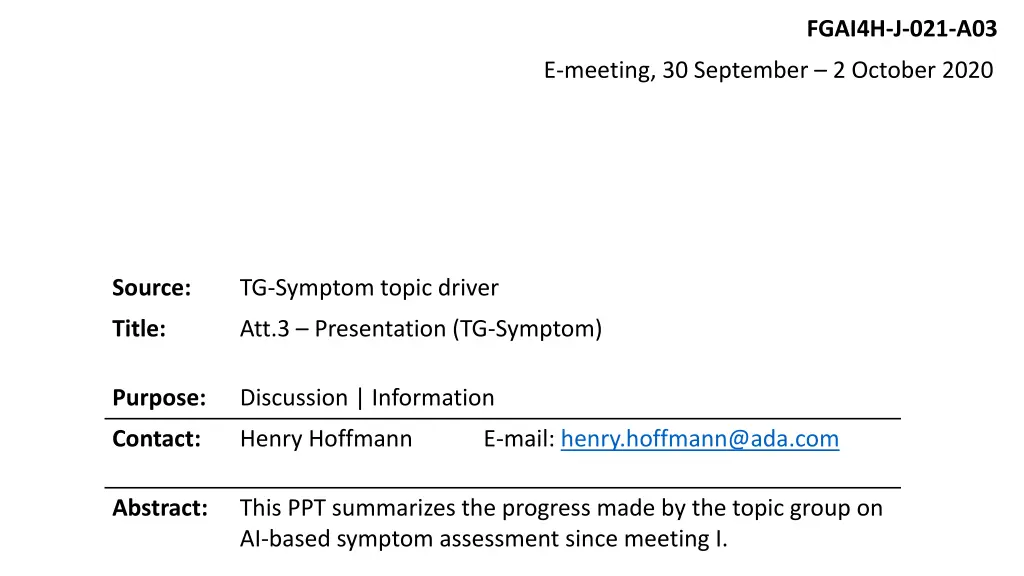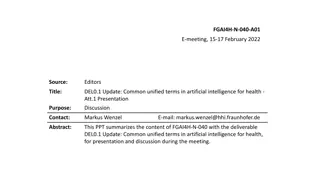
AI-based Symptom Assessment Progress Summary
This presentation provides an update on the progress made by the topic group on AI-based symptom assessment, including discussions and information shared during the E-meeting held from 30th September to 2nd October 2020. The presentation covers the AI task, journey, and approach of the group, along with details on the companies and contributors involved in the topic group. Contact details are also provided for further information.
Download Presentation

Please find below an Image/Link to download the presentation.
The content on the website is provided AS IS for your information and personal use only. It may not be sold, licensed, or shared on other websites without obtaining consent from the author. If you encounter any issues during the download, it is possible that the publisher has removed the file from their server.
You are allowed to download the files provided on this website for personal or commercial use, subject to the condition that they are used lawfully. All files are the property of their respective owners.
The content on the website is provided AS IS for your information and personal use only. It may not be sold, licensed, or shared on other websites without obtaining consent from the author.
E N D
Presentation Transcript
FGAI4H-J-021-A03 E-meeting, 30 September 2 October 2020 Source: TG-Symptom topic driver Title: Att.3 Presentation (TG-Symptom) Purpose: Discussion | Information Contact: Henry Hoffmann E-mail: henry.hoffmann@ada.com Abstract: This PPT summarizes the progress made by the topic group on AI-based symptom assessment since meeting I.
Meeting J Update for the Topic Group Symptom Assessment E-meeting, 30 September 2 October 2020
Assessment What is the AI task this TG deals with? Mobile/Web Applications sometimes called Symptom Checkers that Allow users to enter (INPUT) w users to enter (INPUT) Patient information (age, sex, ) Current presenting Complaints (symptoms, free texts ) To then engage in a dialog similar to a doctor collecting (INPUT) To then engage in a dialog similar to a doctor collecting (INPUT) Additional symptoms, findings, factors, attributes, (lab, imaging, genetics, ) To finally provide the user with (OUTPUT) To finally provide the user with (OUTPUT) Pre-Clinical Triage (emergency, see doctor today, self-care ) Differential Diagnosis (disease A 93%, B 73% - e.g. in ICD10,
Journey & Approach What happened so far? Meeting A Meeting A Geneva A-020: Towards a potential AI4H use case "diagnostic self-assessment apps" Meeting C Meeting C Lausanne, 22 Lausanne, 22- -25 Topic Group created Approach: Approach: MMVB 1.0 MMVB N.0 MVB Meeting F Meeting F Zanzibar Zanzibar 2 2- -5 September 2019 First benchmarking with toy AI & toy Data Minimal Minimal Minimal Minimal viable viable Benchmarking MMVB 1.0 MMVB 1.0 Meeting G, H, I, J Meeting G, H, I, J Gradual increase of complexity by adding model details Geneva, 25 , 25- -27 September 2018 27 September 2018 25 January January 2019 2019 MVB 5 September 2019 Benchmarking
Status of the Topic Group Overview Topic Group Members: Companies (15+2): Companies (15+2): 1DOC3, Ada, Babylon, Baidu, Barkibu Infermedica, Inspired Ideas, Isabel Healthcare, mfine, MyDoctor, Symptify, Visiba Care, xund.ai, Your.MD Independent Independent contributors contributors (5+1): (5+1): Reza Reza Jarral Jarral, Thomas Neumark, Muhammad Murhaba, Pritesh Mistry, Alejandro Osornio, Salman Razzaki Sub Sub- -Topic Groups Topic Groups Self-assessment Clinical symptom assessment fgai4htgsymptom@lists.itu.int fgai4htgsymptom@lists.itu.int 99 (16 more) 8 Online 8 Online meetings meetings since since meeting meeting I I (All with minutes/protocols in SharePoint) (additional bi-weekly tech syncs, clinical sub-group syncs, slack conversations) Barkibu, Buoy, Deepcare, EQL EQL,
Status of the Topic Group What we implemented since meeting I Finished MMVB 2.2 Focus on implementing Berlin Model Attributes + Factor distributions Backend Extended data structures + Frontend API Extended benchmarking case synthesizer Frontend AI self-registration Design & Usablity improvements Toy Ais Started implementation of new API interface + model by Topic Group members Annotation Tool Refactored into a separate tool Extended to Berlin Model too
MMVB 2.2 Benchmarking New start screen
MMVB 2.2 Benchmarking Self-registration of a new Toy AIs
MMVB 2.2 Benchmarking Generating new benchmarking case sets
MMVB 2.2 Benchmarking Creating a new benchmarking session
MMVB 2.2 Benchmarking Running the benchmarking & results
Status of the Non-Technical Work The non-technical things we did TDD TDD work Clinical Group output on scores & metrics merged (+15 pages) Description of the finalization of MMVB 2.2 Outreach Outreach & FG Interaction & FG Interaction Contributed to the new TDD document template (FG-AI4H-J-004) Contributed to the clinical validation working group (Shubhanan Upadhyay from the TG was confirmed as Co-Chair) Contributed to the data annotation questionaire (Contributed to the early Assessment Platform work) work (99 (99 pages pages) )
Next Steps What to focus on next MMVB 3.0 Workshop with TG to Agree on how to organize the definition of a full-scale condition & symptom space AI and Data meta-data annotation system + Interactive drill down (Authentication / Rights & Roles) Implementing new model (frontend, backend, annotation tool) TDD & TDD & Outreach Outreach Aligning next steps with the Assessment Platform Adoption of refined template structure Align with Working Groups and Deliverables E.g. Testing additional tools e.g. the Requirements Traceability Matrix
Thank you! WHO/ITU FG AI4H TG Symptom Assessment Meeting J Update E-meeting, 30 September 2 October 2020


